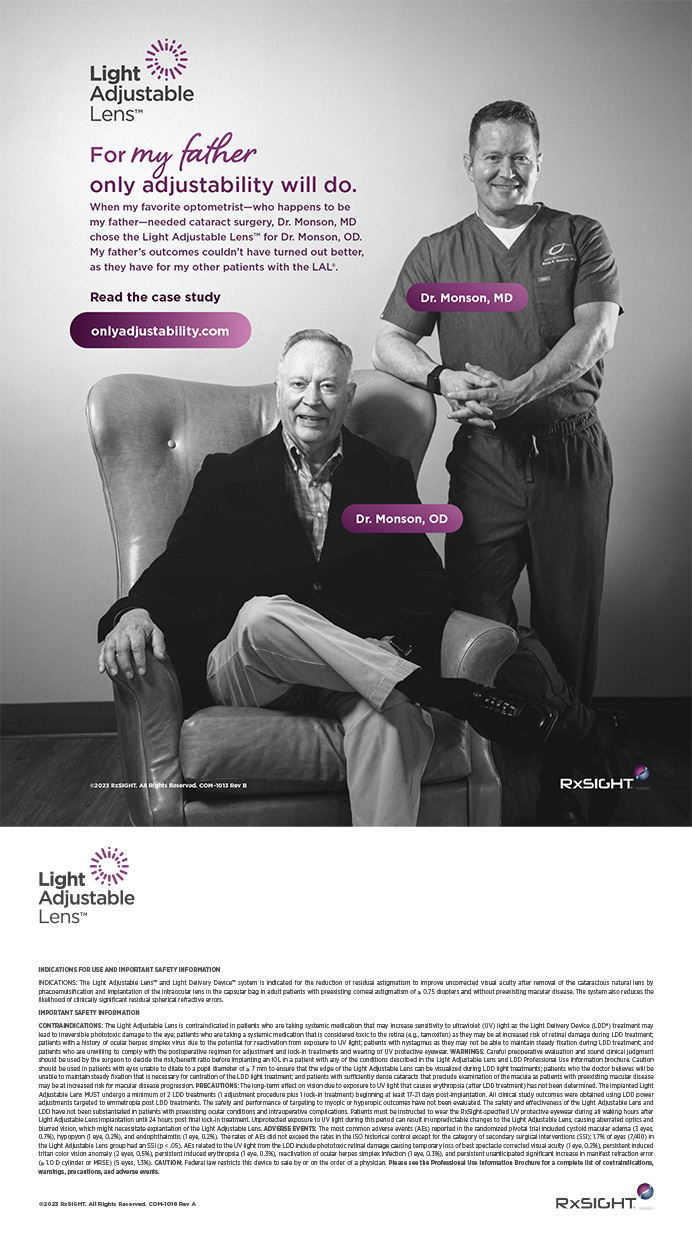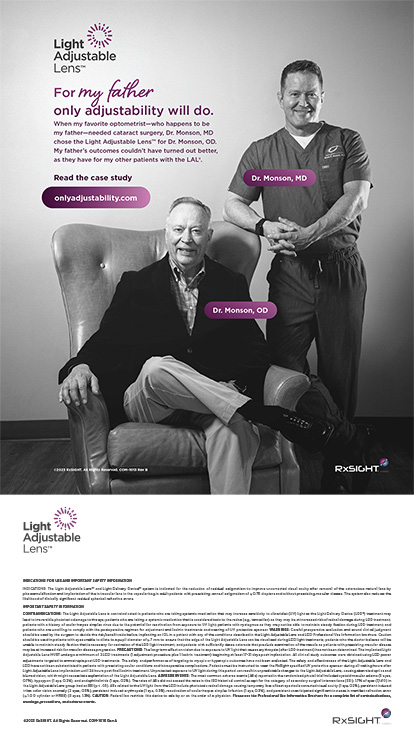In 1895, Hal Foster, MD, was lonely. He had arrived in Kansas City 13 years earlier, the only ear, nose, and throat man in town. By the mid-1890s, although the city was no longer just a stop along the Santa Fe Trail, it was not yet a fully formed metropolis. Dr. Foster sorely missed the fellowship and support of his colleagues back in New York City, where he had studied and started his practice in otorhinolaryngology.
At the time, the northeastern United States boasted a number of vigorous specialty and subspecialty medical societies, each working to advance the understanding of diseases and treatments and the interests of patients and physicians alike. Through meetings and journals, they advocated and argued, learned and taught, met and mingled. Out on the plains of Kansas where Dr. Foster had set down roots, however, the chances for such professional engagement were as scarce as prairie chickens’ teeth.
A YOUNG SPECIALTY
Like Kansas City itself, the science of ophthalmology was young. Von Helmholtz’s ophthalmoscope had been around since the 1850s, but the first topical anesthetic for eye surgery was only a decade old. Before Austrian ophthalmologist Carl Koller, MD (“Coca-Koller”), discovered the eyenumbing effects of cocaine hydrochloride in 1884, doctors relied on the muscle power of burly assistants to steady their patients’ heads during procedures that must have been dynamic in the extreme. Scientific ophthalmology— and the other specialties with which it was grouped—was perched on the cusp of modernity. Dr. Foster understood that, as well as helping to enhance his own medical effectiveness, a productive interchange among the larger body of dedicated practitioners would help to push his chosen field into the light of a new age.
Stymied from meaningful contact with existing medical societies by the communication and travel limitations of the day, Dr. Foster decided to start a group for western ophthalmologists and otolaryngologists. At the time, eye care was logically grouped with that of other important structures found above the shoulders, excepting the teeth and brain. Dr. Foster sent postcards to hundreds of eye, ear, nose, and throat doctors across the southern and western states, inviting them to form a new society to serve their common needs.
WOOL WAS BORN
In the spring of 1896, a few dozen interested specialists made the bumpy, dusty journey to Kansas City, and on April 9 and 10, the Western Ophthalmological, Otological, Laryngological, and Rhinological Association (the WOOL society) was born. Papers were presented; Adolph Alt, MD, was elected the association’s first president and Dr. Foster its first secretary. The founder expressed his vision for the group to its new members, saying, “The little acorn I plant here today will never satisfy me until like an oak, it grows and spreads all over the United States.”1 By the time he died some 5 decades later, Dr. Foster’s oak was spanning the continent.
NEW NAME AND A JOURNAL
Within 2 years, the new group shortened its name to the Western Ophthalmic and Oto-Laryngologic Association. By 1900, the need to increase members and dues led to the opening of membership to all qualified American physicians and to the election of William Ballenger, MD, as secretary. By 1903, Dr. Ballenger was elected president. Along with his concerted recruitment efforts over the previous 2 years, the elimination of regional membership restrictions was reflected in yet another name change—this time to the American Academy of Ophthalmology and Otolaryngology (AAOO). It stuck until 1979. That year, the AAOO published the first edition of Transactions, the journal of its scientific papers that would later become today’s Ophthalmology.
FOUNDATION FOR THE FUTURE
The year 1903 also witnessed the adoption of a revised constitution, which would serve as the foundation for the AAOO’s future endeavors. It codified the group’s mission “to encourage the study and practice of medicine and surgery in relations to the eye, ear, nose, and throat.”2 Just a year later, in a remarkably progressive leap for the times, the AAOO granted membership to a female physician— the first of many to come. The male membership at the time was largely very supportive of this move.
Under the broad rubric of “encouraging study and practice,” the early years of the 20th century saw the AAOO’s educational efforts take center stage, first with presentations and exhibits at annual meetings, and later with complete instructional courses. These were among the first continuing medical education (CME) programs ever developed, and they included instruction provided at annual AAOO meetings as well as home-study courses. The AAOO also involved itself in various public health initiatives, including early campaigns against neonatal conjunctivitis (ophthalmia neonatorum) and what would later be called noise pollution. The cacophony generated by turn-of-the- century urban trolley wheels was especially disquieting and, it was feared, possibly damaging to health.
GROWTH OF THE ACADEMY
After a period of growth in both membership and stature, the AAOO of 1912 was larger than any other society of specialists in American medicine. As such, it began to exercise its influence to help institute a rigorous program program of graduate education, standardized for ophthalmology and otolaryngology students nationwide. By 1916, the AAOO helped establish the country’s first medical specialty board, the American Board of Ophthalmology. After successfully completing both written and oral American Board of Ophthalmology examinations, the first board-certified ophthalmologists began treating patients throughout the United States.
By the end of its first 20 years, the AAOO had finished creating the structural foundation and principled orientation that would guide it through the next century. Its early commitment to expanding the specialties’ knowledge base and educating practitioners remained paramount, but the organization took on an increasing role as a public advocate for its members’ professional wellbeing. This led to an ongoing involvement in state and national politics that continues today.
A SPLIT HAD TO BE MADE
By the 1970s, it became clear that what seemed logical in the 1890s no longer made obvious sense. In order to maximize its service to the two increasingly disparate and unwieldy specialties, the AAOO decided to split in two. In 1979, the American Academy of Ophthalmology (AAO) went to headquarters in San Francisco, and the American Academy of Otolaryngology found a home in Alexandria, Virginia. It was an amicable separation and about time.
In 1980, the AAO founded the Museum of Vision to husband its archives and created the Foundation of the American Academy of Ophthalmology to raise money and implement educational programs. In 1981, the AAO merged with the American Association of Ophthalmology, thereby enhancing its advocacy and political outreach.
Today’s AAO cites its mission as advancing “the lifelong learning and professional interests of ophthalmologists … to ensure that the public can obtain the best possible eye care.” To achieve those goals, the Academy faces several challenges, including the legal encroachment into eye surgery by competing specialties. According to AAO President Randy Johnston, MD, the Academy “continues to feel that surgery should be done by surgeons, and that legislation is not a substitute for education.”
CHALLENGES
Education
Providing CME has been a core service since the Academy’s inception. Over the years, Dr. Johnston says, the AAO has become “a huge provider of [CME] credits, probably the biggest single provider of ophthalmology CME in the country, if not the world.” Early on, the main obstacle to running such classes was the great distance and travel time most doctors had to endure to reach an instruction site. The difficulty nowadays is increasing demands from the Accreditation Council for Continuing Medical Education. Dr. Johnston fears that the Accreditation Council for Continuing Medical Education is “making their requirements for CME ever more stringent, to the point that the Academy and the state ophthalmology medical societies are having a great deal of trouble putting on any approved CME. It is an ongoing battle, and we have yet to figure out where that is going to end up.”
Declining Reimbursement
“For the individual ophthalmologist,” Dr. Johnston feels that “reimbursement is the major challenge that we are looking at.” Scheduled cuts to Medicare reimbursement rates have been postponed several times already, most recently by Congress’ June 24, 2010, action. That postponement is slated to last for 6 months before the issue must be confronted again. Ophthalmologists who treat Medicare patients are “looking at a 21% fee cut just this year, with cuts totaling about 40% in the next 4 to 5 years. So, how to pay for medical services in the face of ever-increasing budget deficits is a huge issue. The Academy and the rest of organized medicine are fighting hard to keep these draconian cuts from going through. What happens is going to be very important to the individual ophthalmologist over the next several years.”
Whatever ensues, AAO leaders and members will face it together. The days of the lonely eye, ear, nose and throat man are long gone.
- Bryan SA.Pioneering Specialists:a History of the American Academy of Ophthalmology and Otolaryngology.Alexandria,VA:American Academy of Otolaryngology;1982:4.
- Bryan SA.Pioneering Specialists:a History of the American Academy of Ophthalmology and Otolaryngology.Alexandria,VA:American Academy of Otolaryngology;1982:13.


